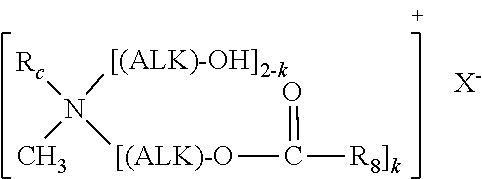Fabric Conditioning Composition
a technology of conditioned compositions and conditioned components, applied in the field of conditioned compositions, can solve the problems of increasing the cost of raw materials required for triethanol amine based esterquat production such as fatty acids and dimethyl sulfate, and not effectively contributing to softening performance, etc., to achieve enhanced softening performance and fragrance delivery, enhanced softening performance, and low active component level
- Summary
- Abstract
- Description
- Claims
- Application Information
AI Technical Summary
Benefits of technology
Problems solved by technology
Method used
Image
Examples
example 1
[0105]In Example 1 a fabric conditioner composition based on methyl diethanol amine tallow fatty acid diesterquat was prepared.
[0106]In Example 1, deionized water was provided at a temperature of 75° C. A water swellable cationic polymer which was a FS200-type polymer from SNF having the trade name Flosoft DP200 available in commerce from SNF Floerger. A buffer in the form of lactic acid was provided. A chelating compound having the formula aminotri(methylenephosphonic acid) in the form of a commercially available chelating compound known under the trade name Dequest 2000 from Monsanto was also provided. The water swellable cationic polymer (0.1 wt %), buffer (0.071 wt %), and chelating compound (0.1 wt %) were added to the water (95.429 wt %), all percentages being with respect to the final composition, and mixed under high shear for 2 minutes.
[0107]Then powdered hard tallow methyl diethanol amine (MDEA) esterquat, comprising at least 90 wt % diesterquat and no more than 10 wt % mo...
examples 2 to 6
[0119]In Examples 2 to 6, the method of Example 1 was repeated to produce a number of different compositions. However, the method was changed so that the homogenization pressure was 6.89×107 Pa (10,000 psi). This higher pressure produced a reduced emulsion average particle size of from 0.1 to 1 microns.
[0120]In these Examples, the homogenized composition comprised 2.5 wt % of the same hard tallow MDEA esterquat as in Example 1. Also, the fragrance amount varied from Examples 2 to 5. In Examples 2 to 5 the fragrance amount was 0.2. 0.3, 0.4 or 0.5 wt % respectively. The fragrance was present as free (i.e. un-encapsulated) fragrance. In Example 6, the fragrance was zero, but with the same 2.5 wt % hard tallow MDEA esterquat.
[0121]The composition of each of Examples 2 to 6 were tested to determine the ability of the compositions to deliver fragrance and provide fragrance intensity onto fabric on day one and to soften the fabric. The results are shown in Table 2.
TABLE 2Day 1CompositionF...
examples 7 to 11
[0123]In Examples 7 to 10, the compositions of Examples 2 to 5 were modified by the incorporation of fragrance capsules to encapsulate the fragrance in the respective compositions. The fragrance capsules are added as a capsule slurry to the composition together with the fragrance prior to homogenization in an amount of 0.3 wt % based on the weight of the final composition. Example 11, like Example 6, included no fragrance, but did include the fragrance capsules.
[0124]The composition of each of Examples 7 to 11 were tested to determine the ability of the compositions to deliver fragrance and provide fragrance intensity onto fabric on day one, tested without rubbing, and to soften the fabric. The results are shown in Table 3.
TABLE 3Day 1CompositionFragranceSoftnessExample 72.5 wt % MDEA esterquat / 0.15.86.1wt % FS200 water swellablecationic polymer / 0.2 wt %fragrance / 0.3 wt % fragrancebooster capsulesExample 82.5 wt % MDEA esterquat / 0.13.356.3wt % FS200 water swellablecationic polymer / 0...
PUM
| Property | Measurement | Unit |
|---|---|---|
| wt % | aaaaa | aaaaa |
| particle size | aaaaa | aaaaa |
| pressure | aaaaa | aaaaa |
Abstract
Description
Claims
Application Information
 Login to View More
Login to View More - R&D
- Intellectual Property
- Life Sciences
- Materials
- Tech Scout
- Unparalleled Data Quality
- Higher Quality Content
- 60% Fewer Hallucinations
Browse by: Latest US Patents, China's latest patents, Technical Efficacy Thesaurus, Application Domain, Technology Topic, Popular Technical Reports.
© 2025 PatSnap. All rights reserved.Legal|Privacy policy|Modern Slavery Act Transparency Statement|Sitemap|About US| Contact US: help@patsnap.com

